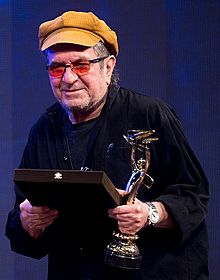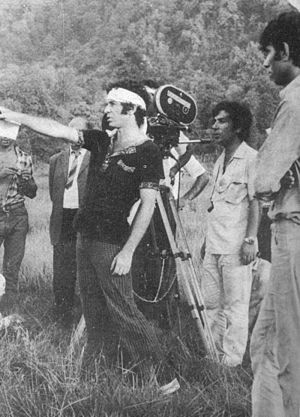Dariush Mehrjui facts for kids
Quick facts for kids
Dariush Mehrjui
|
|
|---|---|

Mehrjui in 2018
|
|
| Born | 8 December 1939 Tehran, Iran
|
| Died | 14 October 2023 (aged 83) Karaj, Iran
|
| Occupation | Filmmaker |
| Years active | 1966–2023 |
| Spouse(s) |
|
| Children | 3 |
Dariush Mehrjui (Persian: داریوش مهرجویی; 8 December 1939 – 14 October 2023) was a famous Iranian filmmaker. He was a very important person in Iranian cinema.
Mehrjui was a founding member of the Iranian New Wave movement. This was a new style of filmmaking that started in the early 1970s. His film, The Cow, is seen as the first film of this movement. Many of his movies were inspired by books and plays, both Iranian and from other countries.
Dariush Mehrjui passed away on October 14, 2023, in his home near Tehran.
Contents
Dariush Mehrjui's Life and Films
His Early Life and Education
Dariush Mehrjui was born in Tehran, Iran. He grew up in a middle-class family. As a child, he loved art, especially painting small pictures called miniatures. He also enjoyed music and played instruments like the santoor and piano.
Mehrjui spent a lot of time watching movies. He especially liked American films. These movies often had text cards that explained the story. He started learning English to understand them better. A film called Bicycle Thieves had a big impact on him. When he was 12, Mehrjui even built his own 35mm projector! He would rent films and sell tickets to his friends.
In 1959, Mehrjui moved to the United States. He studied at the University of California, Los Angeles (UCLA). He first studied film, but he found it too focused on technical details. He switched his major to philosophy and graduated in 1964.
After college, Mehrjui started a magazine called Pars Review. It aimed to share Persian literature with Western readers. He also wrote his first movie script. In 1965, he returned to Tehran. He worked as a journalist and screenwriter. He also taught literature and English.
Starting His Film Career
Dariush Mehrjui made his first film, Diamond 33, in 1966. It was a comedy that made fun of James Bond movies. This film was not very successful.
However, his second film, Gaav (The Cow), changed everything. This symbolic drama was about a simple villager and his strong connection to his cow. The film was based on a short story by Gholamhossein Sa'edi. Mehrjui worked with Sa'edi on the script. He also met actors Ezzatolah Entezami and Ali Nassirian, who would star in many of his future films.
The Cow was finished in 1969. It was initially banned by the government for over a year. This was likely because the writer, Sa'edi, was known for criticizing the government. When it was finally released in 1970, it was highly praised. In 1971, the film was secretly taken out of Iran. It was shown at the Venice Film Festival and became a huge success. It won the International Critics Award there.
The Cow is considered a turning point in Iranian cinema. It helped start the "Iranian New Wave" movement. This film showed a new style of storytelling that was very popular.
While waiting for The Cow to be released, Mehrjui made two more films:
- Agha-ye Hallou (Mr. Naive) in 1970. This was a comedy. It won awards in Iran and was shown at the 7th Moscow International Film Festival. It was also a big hit in Iran.
- Postchi (The Postman) in 1971. This film also faced censorship issues. It was eventually released in 1972. It was shown at major film festivals like Venice, Berlin, and Cannes.
The Cycle and Later Films
In 1973, Mehrjui began making The Cycle. This film was inspired by the illegal blood trade in Iran. It took a long time to get approval to make the film. The Iranian medical community tried to stop it. Filming finally began in 1974.
The Cycle tells the story of Ali, a teenager trying to find medical help for his dying father. They are poor and get involved in unsafe blood donations. The film shows the challenges Ali faces. The title of the film comes from a poem by Hafiz Shirazi. It means "Because of the cycle of the universe, my heart is bleeding."
This film was also banned for three years. It was finally released in 1977. It received great reviews around the world. It won an award at the Berlin Film Festival in 1978.
Around this time, Iran was going through big political changes. The Iranian Revolution of 1979 was happening. This led to a period where artists hoped for more freedom.
Mehrjui also made several documentaries during this time. He made films about kidney transplants and safe blood donations. These films were even used by the World Health Organization.
After the Iranian Revolution
The Iranian Revolution brought big changes to Iran. The old government fell, and a new Islamic Republic was formed. Dariush Mehrjui was excited about the revolution. He filmed many of its daily events. At first, censorship was lifted, and there was more artistic freedom.
Mehrjui then directed The School We Went to in 1980. This film was about students rebelling against their school principal. It was seen as a story about the recent revolution.
In 1981, Mehrjui and his family moved to Paris, France. He lived there for several years. During this time, he made a documentary about the poet Arthur Rimbaud. It was shown at film festivals in Venice and London.
In 1985, Mehrjui returned to Iran. He continued his filmmaking career under the new government.
Some of his important films from this period include:
- Hamoun (1989): This film was about an intellectual whose life is falling apart. It was voted the best Iranian film ever by a film magazine.
- Pari (1995): This film was loosely based on an American book.
- Leila (1997): This was a drama about a couple who learn the wife cannot have children.
His last film, Laminor, was released in 2019.
His Film Style and Impact
Dariush Mehrjui is considered the start of modern Iranian cinema. He brought new ideas to filmmaking, like realism and symbolism. His films were similar to those of famous directors like De Sica and Satyajit Ray. But he also added a unique Iranian touch. He helped start one of the most important film movements in the world.
Mehrjui often focused on the problems of modern, city life in Iran. His film The Pear Tree (1999) is a great example of his look at Iranian society.
Since his film The Cow in 1969, Mehrjui helped create the "Iranian New Wave." This movement changed Iranian cinema forever.
Awards and Recognition
Dariush Mehrjui received many awards during his career. He won 49 national and international awards, including:
- Golden Seashell at the San Sebastián International Film Festival in 1993.
- Silver Hugo at the Chicago International Film Festival in 1998.
- Crystal Simorgh at the Fajr Film Festival in 2004.
- A Lifetime Achievement Award at the 1st Diorama International Film Festival & Market in 2019.
Filmography
- Diamond 33 (1967)
- The Cow (1969)
- Mr. Naive (1970)
- The Postman (1971)
- The Cycle (1975)
- The School We Used to Go (1981)
- Journey to the Land of Rimbaud (1983) (documentary in France)
- The Lodgers (1987)
- The Wild Bafti (1988)
- Hamoun (1990)
- The Lady (1991)
- Sara (1993)
- Pari (1995)
- Leila (1996)
- The Pear Tree (1998)
- The Mix (2000)
- To Stay Alive (2002)
- Mum's Guest (2004)
- Santouri (2007)
- Beloved Sky (2010)
- The Orange Suit (2012)
- Good To Be Back (2013)
- Ghosts (2014)
- La minor (2020)
Images for kids
See also
 In Spanish: Dariush Mehrjui para niños
In Spanish: Dariush Mehrjui para niños




